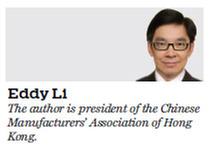Majority support co-location arrangement for express rail

The co-location boundary control arrangement for the Guangzhou-Shenzhen-Hong Kong Express Rail Link terminus in West Kowloon was finally unveiled on July 25. The public generally support the proposal, believing it is a logical and appropriate arrangement. A recent online survey conducted by a media company showed 84 percent of respondents in Hong Kong back this plan, suggesting the arrangement is supported by mainstream public opinion.
As a matter of fact, a joint boundary checkpoint has been implemented for years at the Shenzhen Bay Port, where officers from both Hong Kong and Shenzhen have worked harmoniously within the same building on the Shenzhen side, providing convenient services for traveling residents and tourists. The arrangement proposed by authorities is quite similar - a confined area inside the West Kowloon terminus will be leased to the Chinese mainland for authorized mainland officers to conduct boundary control operations. As long as the area and its functions are clearly specified, the arrangement wouldn't be an issue for general public.
Once the Hong Kong section is linked up with the national high-speed rail network, which exceeds 20,000 kilometers (more than 60 percent of high-speed track worldwide), it will not only benefit the travelers, but will also generate a far-reaching and profound economic impact.

First of all, it will facilitate communication between Hong Kong and other major cities on the mainland. Improved cooperation between the two sides will greatly contribute to Hong Kong's economic development. Second, the living circle of people on both sides will be substantially expanded; what's more, a new tourist route could be formed along the railway. By then, the West Kowloon Cultural District will be a new place of interest in the eyes of tourists, promoting both the tourism and culture industry in Hong Kong. Third, the operation of the express rail can stimulate the labor market - retail, dining and transport facilities will provide abundant job opportunities in society. Last but not least, many trans-boundary buses will be substituted by the rail, which is environmentally friendly in terms of alleviating greenhouse gas production and air pollution, since it will cut about 4,700 tons of carbon dioxide emissions every year.
In addition, as the Belt and Road Initiative moves ahead the mainland's high-speed rail operators are also tapping the international logistics market. It is predictable that the high-speed rail will be a basic and important means of transport in the future world, and Hong Kong cannot afford to be alienated or marginalized in this trend. By connecting to the national railway network, Hong Kong will be more ready to participate in the Belt and Road Initiative and Guangdong-Hong Kong-Macao Greater Bay Area project.
The newly announced arrangement is the result of a long-time discussion and research by the central and special administrative region governments, both of whom want the Express Rail Link in Hong Kong to realize the maximum benefits. The joint checkpoint arrangement should have been a no-brainer, were it not for the politicization by agenda-driven politicians. As expected, after its announcement, some people from the opposition campaign immediately misrepresented this mutually beneficial arrangement as an act of "ceding territory", sabotaging "one country, two systems", and violating the Basic Law. For any sensible people, such notions are absurd and ridiculous.
Ever since the decision was taken for Hong Kong to build the Express Rail Link, these politicians have made every attempt to obstruct the project. The only reason for their objection is an anti-mainland sentiment, which abhors any move to further Hong Kong's integration with the mainland. The rail link, which facilitates closer ties between the two sides, is understandingly a thorn in their flesh. Opposing the joint checkpoint is the only means they have to stop the project.
But the reality is that the average daily flow of people between Hong Kong and the mainland exceeds 600,000. The crowds at Lo Wu, Huanggang, Lok Ma Chau and Shenzhen Bay ports testify to the close ties between the two sides. This is not surprising at all. People do need to shuttle back and forth over the boundary for various reasons, including visiting relatives, conducting business and sightseeing. No anti-mainland maneuver can ever sever the close connection between the two sides, no matter how hard the ill-willed politicians try.
In his recent visit President Xi Jinping advised Hong Kong people to seize the opportunities and focus on economic development. From any perspective, Hong Kong is the beneficiary of the one-stop boundary control for the Express Rail Link. This perfect chance to join the national network of railways cannot be missed due to some misleading opinions.
(HK Edition 08/14/2017 page8)
Today's Top News
- Xi's article on developing new quality productive forces to be published
- Beijing protests new US arms sale to Taiwan
- Economic growth in 'upward momentum'
- Strong ties with Thailand stressed
- Japan warned on Taiwan interference
- Takaichi's dangerous rhetoric revives Japan's militaristic past






























